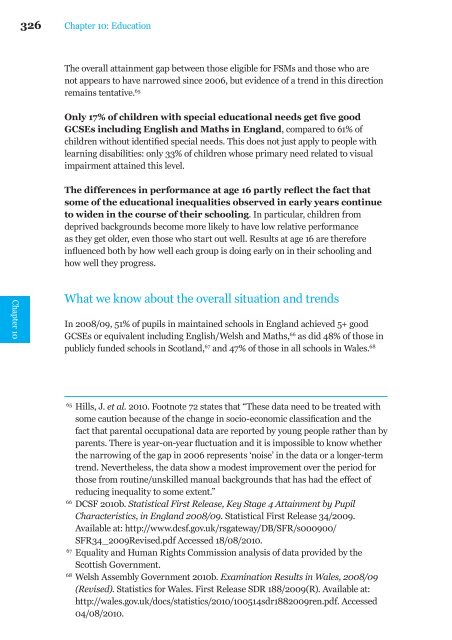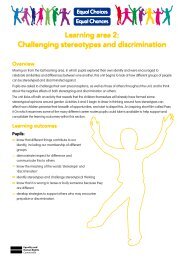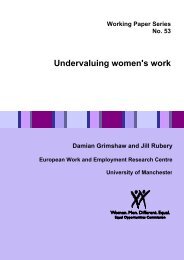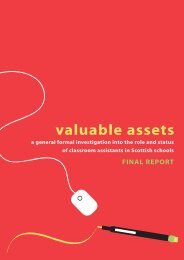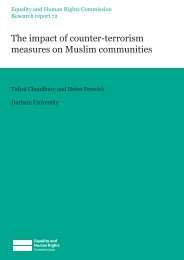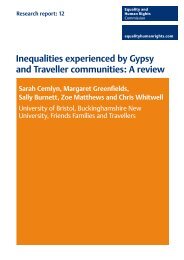Chapter 10: Education - Equality and Human Rights Commission
Chapter 10: Education - Equality and Human Rights Commission
Chapter 10: Education - Equality and Human Rights Commission
You also want an ePaper? Increase the reach of your titles
YUMPU automatically turns print PDFs into web optimized ePapers that Google loves.
326<br />
<strong>Chapter</strong> <strong>10</strong>: <strong>Education</strong><br />
The overall attainment gap between those eligible for FSMs <strong>and</strong> those who are<br />
not appears to have narrowed since 2006, but evidence of a trend in this direction<br />
remains tentative. 65<br />
Only 17% of children with special educational needs get five good<br />
GCSEs including English <strong>and</strong> Maths in Engl<strong>and</strong>, compared to 61% of<br />
children without identified special needs. This does not just apply to people with<br />
learning disabilities: only 33% of children whose primary need related to visual<br />
impairment attained this level.<br />
The differences in performance at age 16 partly reflect the fact that<br />
some of the educational inequalities observed in early years continue<br />
to widen in the course of their schooling. In particular, children from<br />
deprived backgrounds become more likely to have low relative performance<br />
as they get older, even those who start out well. Results at age 16 are therefore<br />
influenced both by how well each group is doing early on in their schooling <strong>and</strong><br />
how well they progress.<br />
<strong>Chapter</strong> <strong>10</strong><br />
What we know about the overall situation <strong>and</strong> trends<br />
In 2008/09, 51% of pupils in maintained schools in Engl<strong>and</strong> achieved 5+ good<br />
GCSEs or equivalent including English/Welsh <strong>and</strong> Maths, 66 as did 48% of those in<br />
publicly funded schools in Scotl<strong>and</strong>, 67 <strong>and</strong> 47% of those in all schools in Wales. 68<br />
65<br />
Hills, J. et al. 20<strong>10</strong>. Footnote 72 states that “These data need to be treated with<br />
some caution because of the change in socio-economic classification <strong>and</strong> the<br />
fact that parental occupational data are reported by young people rather than by<br />
parents. There is year-on-year fluctuation <strong>and</strong> it is impossible to know whether<br />
the narrowing of the gap in 2006 represents ‘noise’ in the data or a longer-term<br />
trend. Nevertheless, the data show a modest improvement over the period for<br />
those from routine/unskilled manual backgrounds that has had the effect of<br />
reducing inequality to some extent.”<br />
66<br />
DCSF 20<strong>10</strong>b. Statistical First Release, Key Stage 4 Attainment by Pupil<br />
Characteristics, in Engl<strong>and</strong> 2008/09. Statistical First Release 34/2009.<br />
Available at: http://www.dcsf.gov.uk/rsgateway/DB/SFR/s000900/<br />
SFR34_2009Revised.pdf Accessed 18/08/20<strong>10</strong>.<br />
67<br />
<strong>Equality</strong> <strong>and</strong> <strong>Human</strong> <strong>Rights</strong> <strong>Commission</strong> analysis of data provided by the<br />
Scottish Government.<br />
68<br />
Welsh Assembly Government 20<strong>10</strong>b. Examination Results in Wales, 2008/09<br />
(Revised). Statistics for Wales. First Release SDR 188/2009(R). Available at:<br />
http://wales.gov.uk/docs/statistics/20<strong>10</strong>/<strong>10</strong>0514sdr1882009ren.pdf. Accessed<br />
04/08/20<strong>10</strong>.


